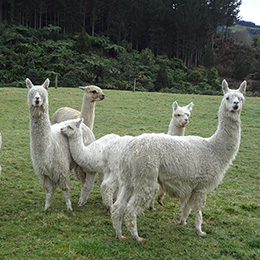 Alpaca
Alpaca
Vicugna pacos
There are two breeds of alpaca; the Suri alpaca and the Huacaya alpaca.
Alpacas are kept in herds that graze on the level heights of the Andes of southern Peru, northern Bolivia, Ecuador, and northern Chile at an altitude of 3,500 m (11,500 ft) to 5,000 m (16,000 ft) above sea level, throughout the year.[1] Alpacas are considerably smaller than llamas, and unlike llamas, they were not bred to be beasts of burden, but were bred specifically for their fiber. Alpaca fiber is used for making knitted and woven items, similar to wool. These items include blankets, sweaters, hats, gloves, scarves, a wide variety of textiles and ponchos in South America, and sweaters, socks, coats and bedding in other parts of the world. The fiber comes in more than 52 natural colors as classified in Peru, 12 as classified in Australia and 16 as classified in the United States.
In the textile industry, "alpaca" primarily refers to the hair of Peruvian alpacas, but more broadly it refers to a style of fabric originally made from alpaca hair, but now often made from similar fibers, such as mohair, Icelandic sheep wool, or even high-quality English wool.[citation needed] In trade, distinctions are made between alpacas and the several styles of mohair and luster.
An adult alpaca generally is between 81 and 99 cm in height at the withers. They usually weigh between 48 and 84 kg (106 and 185 lbs).
Further Reading :
http://en.wikipedia.org/wiki/Alpaca
Copyright © 2015 Mill Creek Bird & Animal Encounters. All rights reserved.